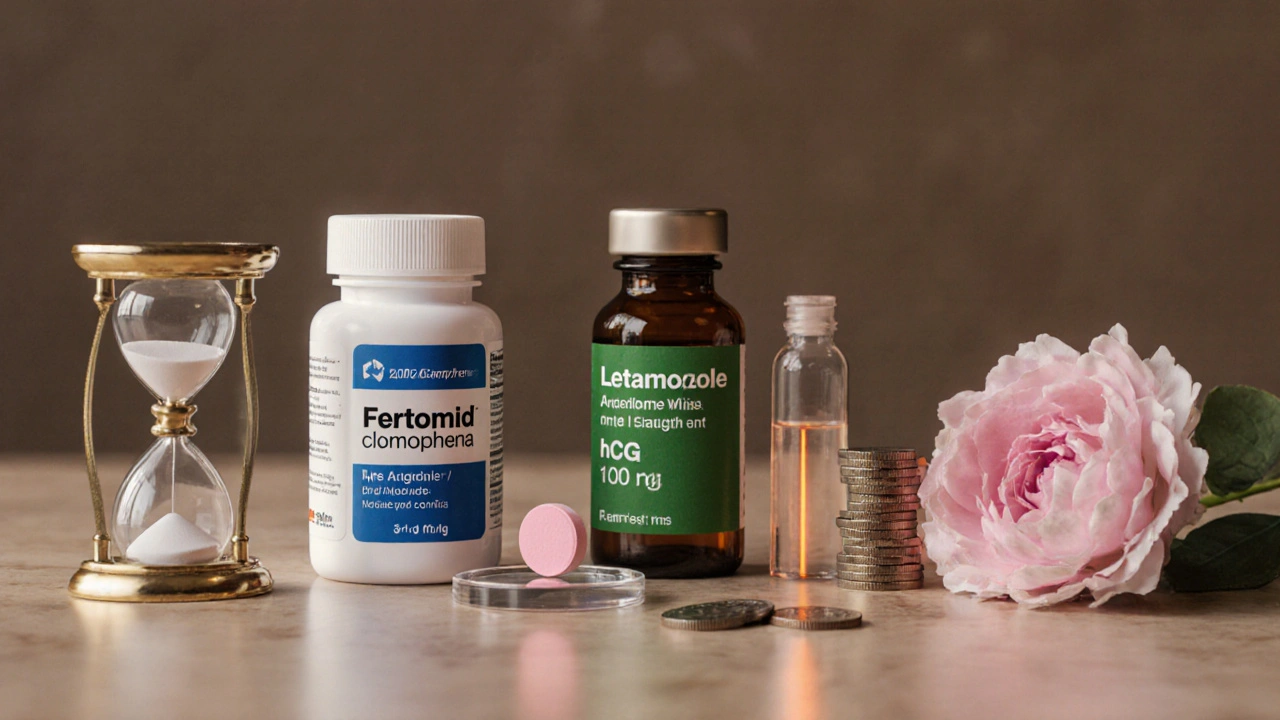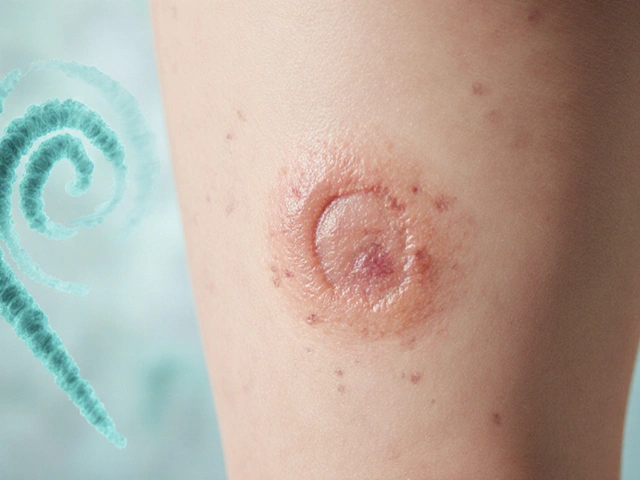Male Infertility Treatment Comparison Tool
Enter Your Symptoms & Preferences
Recommended Treatment:
Details:
Quick Take
- Fertomid (clomiphene citrate) works by blocking estrogen feedback, boosting testosterone and sperm production.
- Letrozole and anastrozole are aromatase inhibitors that lower estrogen more directly, often used when estrogen is high.
- Tamoxifen shares clomiphene’s estrogen‑blockade but has a different side‑effect profile.
- Human chorionic gonadotropin (hCG) and recombinant FSH are injectable hormones that stimulate the testes directly.
- Cost, route of administration, and side‑effects are the biggest decision factors.
When a couple hits a roadblock trying to conceive, doctors often turn to medication that can kick‑start a man’s spermatogenesis. Fertomid is a brand of clomiphene citrate used off‑label to stimulate testosterone production in men with hypogonadism and to improve sperm count. The big question many patients ask is: "Is Fertomid the right choice, or should I look at other options?" This guide breaks down the science, the costs, and the real‑world outcomes so you can decide which route fits your life.
How Fertomid (Clomiphene) Works
Clomiphene is a selective estrogen receptor modulator (SERM). In men, it blocks estrogen receptors in the hypothalamus, tricking the brain into thinking estrogen levels are low. The pituitary responds by releasing more luteinizing hormone (LH) and follicle‑stimulating hormone (FSH). Those hormones travel to the testes, boosting testosterone and sperm production.
Typical dosing for male infertility runs between 25mg and 50mg daily, taken orally. Most studies show a 30‑40% increase in sperm concentration after three to six months, with a pregnancy‑rate boost of roughly 10‑15% when paired with a fertile partner.
Top Alternative Treatments
Below are the most common alternatives physicians prescribe when Fertomid isn’t a perfect fit.
Letrozole (Femara)
Letrozole is an aromatase inhibitor that stops the conversion of testosterone to estrogen. By lowering estrogen, the hypothalamus naturally ramps up LH and FSH. Doses for men are usually 2.5mg-5mg every other day. It can be especially helpful when blood tests show a high estradiol level.
Anastrozole (Arimidex)
Another aromatase inhibitor, anastrozole, works similarly to letrozole but has a slightly longer half‑life. Typical male dosing is 0.5mg-1mg daily. Studies suggest a modest rise in testosterone (5‑10%) and comparable sperm improvements to clomiphene.
Tamoxifen (Nolvadex)
Like clomiphene, tamoxifen is a SERM. It blocks estrogen receptors in the brain and also in breast tissue, reducing estrogen‑related side effects. Doses range from 10mg to 40mg daily. Some men tolerate tamoxifen better than clomiphene, reporting fewer visual disturbances.
Human Chorionic Gonadotropin (hCG)
hCG mimics LH and directly stimulates Leydig cells in the testes to produce testosterone. It’s administered via subcutaneous injection, usually 500‑1500IU two to three times a week. When combined with clomiphene or an aromatase inhibitor, hCG can boost sperm count dramatically, but the injection route can be a barrier for some.
Recombinant Follicle‑Stimulating Hormone (rFSH)
rFSH works downstream of the pituitary, directly encouraging the Sertoli cells that nurture sperm development. Doses start around 75‑150IU three times a week. It’s often reserved for men with very low sperm counts (<5million/mL) because it’s pricey.
Lifestyle & Supplement Boosters
While not prescription drugs, zinc (30mg), vitaminD (2000IU), and omega‑3 fatty acids have documented links to improved semen parameters. They’re cheap, low‑risk, and can be used alongside any of the medicines above.
Side‑Effect Snapshot
Every medication carries trade‑offs. Below is a quick look at the most common adverse events.
- Fertomid (clomiphene): visual disturbances, mood swings, occasional weight gain.
- Letrozole/Anastrozole: joint pain, hot flashes, rare liver‑enzyme elevations.
- Tamoxifen: risk of blood clots (very low in men), mild nausea.
- hCG: gynecomastia (breast growth), headaches, injection site bruising.
- rFSH: injection site pain, potential for multiple pregnancies if partner is fertile.

Cost & Convenience Comparison
Money matters, especially if insurance only covers a portion of the treatment. The table below puts the main factors side‑by‑side.
| Medication | Mechanism | Typical Dose & Route | Average Monthly Cost (US$) | Pregnancy Rate Boost | Key Side‑Effects |
|---|---|---|---|---|---|
| Fertomid | SERM - blocks estrogen feedback | 25‑50mg oral daily | ≈45 | +10‑15% (when paired with partner) | Visual blur, mood swings |
| Letrozole | Aromatase inhibitor | 2.5‑5mg oral every other day | ≈60 | +8‑12% | Joint pain, hot flashes |
| Tamoxifen | SERM - similar to clomiphene | 10‑40mg oral daily | ≈50 | +9‑13% | Clot risk, nausea |
| hCG | LH‑like hormone | 500‑1500IU injection 2‑3×/wk | ≈120 | +15‑20% (often combined) | Gynecomastia, injection pain |
| rFSH | Direct Sertoli stimulation | 75‑150IU injection 3×/wk | ≈300 | +18‑25% (severe oligospermia) | Injection site reactions |
Choosing the Right Option: Decision Checklist
- Hormone profile first. If your estradiol is high, an aromatase inhibitor (letrozole or anastrozole) may be more efficient.
- Route matters. If needles are a deal‑breaker, stick with oral agents (clomiphene, tamoxifen, aromatase inhibitors).
- Cost sensitivity. Fertomid and tamoxifen are the cheapest oral choices; injectable hormones drive the price up quickly.
- Side‑effect tolerance. Visual issues point toward tamoxifen; clot concerns push you toward clomiphene or aromatase inhibitors.
- Goal timeline. For a quick 3‑month trial, start with an oral SERM; if you’ve tried that and failed, add hCG or rFSH.
Many clinics run a step‑wise protocol: start with Fertomid, assess labs after 8 weeks, then either increase dose or add an aromatase inhibitor. If sperm counts remain low, they introduce hCG or rFSH as a second line.
Real‑World Patient Stories (What Works in Practice)
Case1 - Alex, 32, high estradiol (45pg/mL). His endocrinologist began letrozole 2.5mg every other day. After three months, estradiol fell to 28pg/mL, testosterone rose by 180ng/dL, and sperm count jumped from 8M/mL to 22M/mL. Alex married the medication’s oral convenience and the modest cost.
Case2 - Brian, 38, low testosterone (250ng/dL) and normal estradiol. He tried Fertomid 50mg daily. Six weeks later, testosterone was 480ng/dL, but he complained of blurry vision. Switching to tamoxifen 20mg daily resolved the visual issue while keeping testosterone up.
Case3 - Carlos, 41, severe oligospermia (3M/mL). A combined regimen of clomiphene 25mg daily plus hCG 1000IU twice a week lifted his count to 12M/mL within four months. The cost was higher, but the couple succeeded on the first try.
Bottom Line: When to Pick Fertomid
If you have a normal estradiol level, can tolerate oral pills, and are watching your budget, Fertomid alternatives like clomiphene remain the go‑to first‑line therapy. It’s cheap, easy, and backed by decades of data. Switch to aromatase inhibitors or injectables only if labs or side‑effects tell you the SERM isn’t cutting it.
Frequently Asked Questions
Can Fertomid be used long‑term?
Most doctors limit clomiphene use to 6‑12months because long‑term estrogen‑blockade can affect bone density. Periodic breaks or switching to a lower‑dose aromatase inhibitor can help maintain safety.
Is Fertomid approved for male infertility?
No. Fertomid is FDA‑approved for female ovulation induction. Its use in men is off‑label, but dozens of peer‑reviewed studies support its efficacy for raising testosterone and sperm counts.
How quickly can I expect results?
Sperm production cycles take about 74days, so most clinicians advise a minimum of three months before re‑testing. Some men notice a rise in testosterone within 2‑4weeks, but sperm improvements lag behind.
Should I combine Fertomid with supplements?
Zinc (30mg), vitaminD (2000IU), and omega‑3s are low‑cost boosters that can augment any pharmacologic plan. They don’t replace medication but can fine‑tune hormone balance.
What are the warning signs that I need to stop the drug?
Severe visual disturbances, persistent mood swings, signs of blood clots (painful swelling, shortness of breath), or abnormal liver tests should prompt an immediate stop and a doctor’s review.








11 Comments
Krishna Chaitanya September 28, 2025
Man I tried Fertomid and felt like a superhero after a few weeks! My test results jumped and I could see hope again. The side effects were barely there, just a tiny headache that vanished. If you’re scared of pills this oral miracle is worth a shot.
diana tutaan September 28, 2025
Clomiphene raises sperm count but data shows only modest pregnancy increase. The cost advantage is real however the visual disturbances can be problematic. Consider aromatase inhibitors if estradiol is high.
Ajay D.j September 28, 2025
From a cultural standpoint many families view male infertility as taboo yet medication like Fertomid opens doors. I’ve seen friends regain confidence after treatment. If you’re hesitant start with a low dose and monitor labs.
Dion Campbell September 28, 2025
Honestly the whole clomiphene hype is overrated. Sure some labs show a 30% boost but the clinical relevance is debatable. Most men could just focus on lifestyle changes rather than pop a cheap pill.
Burl Henderson September 28, 2025
The endocrine feedback loop is essentially modulated by SERM activity; clomiphene acts as an antagonist at hypothalamic ER, prompting LH/FSH upregulation. In practice this translates to increased testosterone synthesis and spermatogenesis. For patients with normozoospermia, adjunctive hCG can synergize the effect.
Leigh Ann Jones September 29, 2025
Reading through the comparison, I couldn’t help but notice how each therapy is presented with a list of pros and cons that feels almost like a sales brochure. The opening paragraph glorifies Fertomid as if it were a miracle cure, yet the subsequent sections admit that the increase in pregnancy rates is only modest. While the mechanism of clomiphene is indeed fascinating, blocking estrogen receptors to stimulate LH and FSH, the real world outcomes depend heavily on baseline hormone levels and the duration of therapy. Moreover, the article glosses over the fact that visual disturbances, while reported as low incidence, can be quite disconcerting for patients who are not warned in advance. The alternative aromatase inhibitors such as letrozole and anastrozole are described as superior when estradiol is high, but the data supporting their use in men is still limited and largely anecdotal. Tamoxifen is mentioned as having fewer side effects, yet the citation of comparative studies is missing, leaving the reader to wonder about the strength of evidence. The injectable options, hCG and rFSH, are correctly noted as more invasive, but the cost implications are understated, especially considering the need for multiple weekly administrations. I also find the cost preference section simplistic; low‑cost oral therapy may be appealing, but insurance coverage and regional pricing variations can dramatically change affordability. The recommendation algorithm in the interactive tool seems to pivot on a single variable at a time, which does not reflect the multifactorial decision‑making process clinicians use. Patients often need a tailored approach that weighs hormone panels, sperm parameters, lifestyle factors, and personal preferences simultaneously. Additionally, the article fails to mention the potential benefit of combining therapies, such as using clomiphene with intermittent hCG bursts, a strategy that has shown promise in some small studies. The lack of discussion on monitoring protocols, such as periodic testosterone and estradiol checks, is a notable omission. Finally, the emotional aspect of infertility is barely touched upon, despite being a major driver for many couples seeking treatment. In summary, while the guide provides a useful overview, it would benefit from deeper analysis, more robust citations, and a balanced presentation of both efficacy and limitations.
Sarah Hoppes September 29, 2025
Big pharma hides the truth the drugs are only a test they want us to take and the data is fabricated
Robert Brown September 29, 2025
Don't waste money on that
Erin Smith September 29, 2025
Stay hopeful there are options that fit your budget and lifestyle keep talking to your doctor
George Kent September 29, 2025
Patriots know our health system works best when we trust home‑grown science; no foreign pharma gimmicks!!! 🇺🇸💪
Jonathan Martens September 29, 2025
Sure let’s all ignore the fact that half the studies cited are underpowered while we keep shoving the same SERM onto men like it’s a one‑size‑fits‑all solution; maybe next time we’ll read the fine print before prescribing.